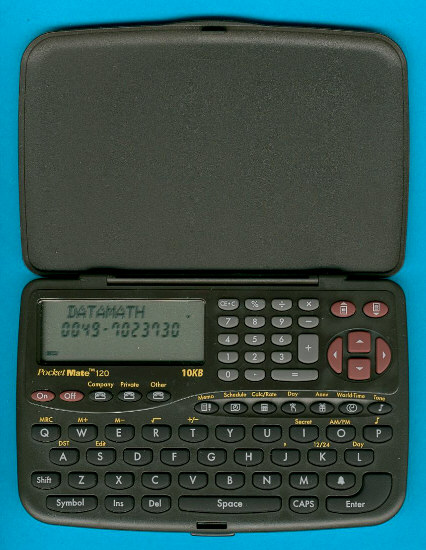
DATAMATH CALCULATOR MUSEUM
 |
DATAMATH CALCULATOR MUSEUM |
Texas Instruments PocketMate 120
| Date of introduction: | 1998 | Display technology: | LCD |
| New price: | Display size: | 12 char + 2*12 digits | |
| Size: | 3.5" x 5.3" x 0.5" 88 x 134 x 13 mm3 |
||
| Weight: | 3.5 ounces, 98 grams | Serial No: | 0262245 |
| Batteries: | 2*CR2025 | Date of manufacture: | mth 09 year 1998 |
| AC-Adapter: | Origin of manufacture: | Thailand (C) | |
| Precision: | 10 | Integrated circuits: | single-chip CPU RAM: 8k Bytes |
| Memories: | 10k Bytes RAM | ||
| Program steps: | Courtesy of: | Joerg Woerner | |
| Download manual: | |
 The
PocketMate 120 was introduced together with the siblings PocketMate
100 and PocketMate 140 late in the market. The
PocketMate 120 is the successor of the PS-3660i.
The
PocketMate 120 was introduced together with the siblings PocketMate
100 and PocketMate 140 late in the market. The
PocketMate 120 is the successor of the PS-3660i.
The PocketMate 120 Databank features 6 useful functions:
| • The Telephone Directory stores names, addresses and
telephone numbers • The Scheduler stores appointments, meeting times and reminders • A flexible clock with 12-hour AM/PM or 24-hour time showing day of week • A calendar displays day of week and year of any schedule entry • A calculator with 10-digits display capacity and 12-digits of accuracy • World time of 30 cities in all 24 time zones supporting one home city and one world city |
The display of the PocketMate 120 consists of one line for alphanumeric characters and two lines supporting only numbers.
 The
inside view of the PocketMate 120 gives a simple construction using only one Integrated
Circuit scanning the keyboard, driving the display and storing data in the
internal memory and one additional memory chip.
The
inside view of the PocketMate 120 gives a simple construction using only one Integrated
Circuit scanning the keyboard, driving the display and storing data in the
internal memory and one additional memory chip.
 A closer view gives you
the differences between this PocketMate 120 and the simpler PocketMate 100. The area
marked RAM is populated with a 8k Byte chip on the PocketMate 120 and kept free on the
PocketMate 100. The small chip is placed on the printed circuit board (PCB) and bonded with about 28 wires direct to
it.
A small "top glop" - the black epoxy resin found on top of the
Application Specific CPU on
the right - is placed above the circuit to protect it. This technique called
chip-on-board (COB) is very common in far- east assemblies of the late 90s. Early products like
the PS-2100 used COB technology to reduce the size of the
PCB, later designs to lower manufacturing costs.
A closer view gives you
the differences between this PocketMate 120 and the simpler PocketMate 100. The area
marked RAM is populated with a 8k Byte chip on the PocketMate 120 and kept free on the
PocketMate 100. The small chip is placed on the printed circuit board (PCB) and bonded with about 28 wires direct to
it.
A small "top glop" - the black epoxy resin found on top of the
Application Specific CPU on
the right - is placed above the circuit to protect it. This technique called
chip-on-board (COB) is very common in far- east assemblies of the late 90s. Early products like
the PS-2100 used COB technology to reduce the size of the
PCB, later designs to lower manufacturing costs.
The design of the PocketMate 120 fits neatly with the PocketMate 300 series.
The whole PocketMate series was discontinued in 2000.
If you have additions to the above article please email: joerg@datamath.org.
© Joerg Woerner, January 17, 2002. No reprints without written permission.